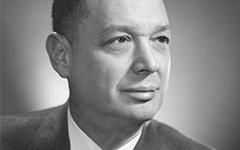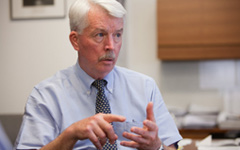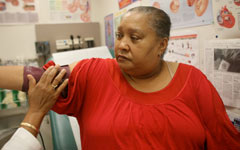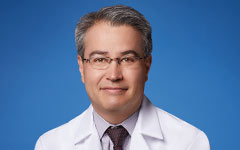From the beginning, the Department of Environmental Medicine at the Icahn School of Medicine at Mount Sinai has been blazing new trails as we help change the entire approach to western health care, from one of treatment after the fact to one that calls first for strategic prevention.
Historic Milestones
1960
The Mount Sinai Hospital’s first environmental health laboratory is established.
1963
The Environmental Sciences Laboratory is created with Irving Selikoff, MD, as director.
1965
The nation’s first hospital division dedicated to environmental and occupational medicine is founded at The Mount Sinai Hospital by Irving J. Selikoff, MD.
1965
The Department of Community Medicine is established at the Icahn School of Medicine at Mount Sinai, and is later renamed the Department of Preventive Medicine.

1965
George James, MD, former Commissioner of Health for New York City, becomes the Department’s first Chair.

1968
Kurt W. Deuschle, MD, is named Chairman of the Department, with Occupational and Environmental, Social Work, Behavioral Sciences, Medical Practice, Education, Nutrition, and Health Economics divisions.
1969
The Edith J. Baerwald Professor of Community Medicine (in social work) endowed chairmanship is established, the first such chair in a U.S. medical school and the first endowed chair at Mount Sinai to be held by a woman.
1970
Mount Sinai holds world's first course on asbestosis, a post-grad course, created by Irving Selikoff, MD.
1971
The Department creates a General Community Medicine residency program with four slots.
1979
The Department creates an International Division.
1987
The Selikoff Centers for Occupational Health, part of the New York State Occupational Health Clinic Network, are established.
1989
The New York State Education Department approves a two-year Master of Science degree in Community Medicine which eventually grows to become the Master of Public Health Program.

1990
Philip J. Landrigan, MD, MSc, is appointed Chair.
1995
The Division of International Health establishes an occupational residency program in Mexico, modeled after the existing program at The Mount Sinai School of Medicine (later named the Icahn School of Medicine at Mount Sinai).

1999
The Department establishes one of the first Pediatric Environmental Health Specialty Units, now funded by the Agency for Toxic Substances and Disease Registry.
1999
The Postdoctoral Fellowship in Children’s Environmental Health is established through an NIEHS grant.

2002
The Mount Sinai Hospital begins providing critically important medical services to 9/11 workers and volunteers enrolled in the federally funded World Trade Center Health Program (WTCHP). As the largest WTCHP Clinical Center of Excellence, we have provided services to more than 22,000 responders since 2002.
2007
The Children’s Environmental Health Center is founded.
2009
In partnership with the Department of Population Health Science and Policy and the Arnhold Institute for Global Health, new PhD programs in epidemiology and biostatistics are created.
2009
Originally named the Department of Community and Preventive Medicine, leadership changes its name to the Department of Preventive Medicine.
2015
One of the nation’s first Exposome research programs, The Senator Frank Lautenberg Laboratory for Environmental Health Sciences, opens.

2015
Robert O. Wright, MD, is appointed Chair of the Department of Preventive Medicine. Dr. Wright is a pediatrician, epigeneticist, and environmental epidemiologist.
2016
The Department of Preventive Medicine is renamed Department of Environmental Medicine and Public Health.
2017
Creation of the Institute for Exposomic Research
2020
Established the Laboratory for Innovation in Exposomic Precision Medicine
2023
NIEHS awards $8.45 million for the Center on Health and Environment Across the LifeSpan (HEALS), a P30 Center